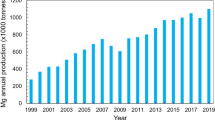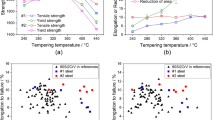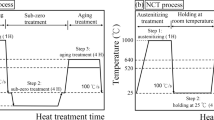Abstract
The effect of a magnetic field on the Gibbs free energy of a material depends on its magnetization behaviors. To investigate the change in the Fe-Fe3C phase diagram caused by a high external magnetic field, the magnetic Gibbs free energies of the phases such as austenite, ferrite, and cementite are calculated on the basis of the molecular field theory. Using the calculated Gibbs free energy as a function of weight percent carbon and temperature at a particular magnetic field, a phase diagram of the Fe-Fe3C system is drawn. The phase diagram is shifted upward so that the Ac 1 and Ac 3 temperatures increase as the magnetic field is applied, but the Ac m temperature change is almost independent of applied magnetic field value. The increase of eutectoid temperature and composition and its application to microstructural control are discussed.
Similar content being viewed by others
References
K. Shimizu and T. Kakeshita: Iron Steel Inst. Jpn. Int., 1989, vol. 29, p. 97.
T. Kakeshita, T. Saburi, K. Kindo, and S. Endo: Jpn. J. Appl. Phys., 1997, vol. 36, p. 7083.
C.M.B. Bacaltchuk, G.A. Castello-Branco, M. Ebrahimi, H. Garmestani, and A.D. Rollett: Scripta Mater., 2003, vol. 48, pp. 1343–47.
N. Masahashi, M. Matsuo, and K. Watanabe: J. Mater. Res., 1998, vol. 13, pp. 457–61.
C.G. de Andres, F.G. Caballero, C. Capdevila, and L.F. Alvarez: Mater. Characterization, 2002, vol. 48, pp. 101–11.
B.D. Cullity: Introduction to Magnetic Materials, Addison-Wesley, London, 1972, p. 117.
D. Jiles: Introduction to Magnetism and Magnetic Materials, Chapman & Hall, 1991, p. 247.
G.J. Shiflet, J.R. Bradley, and H.I. Aaronson: Metall. Trans. A, 1978, vol. 9A, pp. 999–1008.
S. Arajs and D.S. Miller: J. Appl. Phys., 1964, vol. 35, p. 2424.
G. Gorodestsky, S. Shtrikman, and D. Treves: Solid State Commun., 1966, vol. 4, pp. 147.
S. Arajs and D.S. Miller: J. Appl. Phys., 1960, vol. 31, p. 986.
H.P.J. Wijn: Landolt-Bomstein III-19a, Springer-Verlag, Berlin, 1986, p. 24.
H.P.J. Wijn: Landolt-Bornstein III-19c, Springer-Verlag, Berlin, 1988, p. 24.
A.T. Dinsdale: CALPHAD, 1991, vol. 15, p. 317.
K. Abiko and K. Sadamori: Phys. Status, Solidi., 1998, vol. 167 (a), p. 275.
E.A. Wilson: Mater. Sci. Technol., 1995, vol. 11, p. 1110.
V. Messeria: Metal Handbook: Heat Treating, ASM, Metals Park, OH, 1981, vol. 4, p. 9.
J.K. Choi, H. Ohtsuka, Y. Xu, and W.Y. Choo: Scripta Mater., 2000, vol. 43, p. 221.
Author information
Authors and Affiliations
Rights and permissions
About this article
Cite this article
Joo, H.D., Kim, S.U., Koo, Y.M. et al. An effect of a strong magnetic field on the phase transformation in plain carbon steels. Metall Mater Trans A 35, 1663–1668 (2004). https://doi.org/10.1007/s11661-004-0075-y
Received:
Issue Date:
DOI: https://doi.org/10.1007/s11661-004-0075-y




